The iPad Air Review
by Anand Lal Shimpi on October 29, 2013 9:00 PM ESTGPU Performance
Since the iPad Air uses the same A7 silicon as the iPhone 5s, it also uses the same on-die GPU as the 5s: IMG’s PowerVR G6430. This is a 4-cluster configuration of IMG’s latest graphics hardware, running at some relatively high frequency. I already went into some detail on the G6430 in our 5s review so I won’t rehash that here, but we’re basically looking at a shift to a more efficient scalar architecture.
I still don’t have confirmations of clock speeds, but I believe we’re looking at a max GPU clock of around 450MHz. As you’ll see from the results below, there’s a small difference in performance between the iPad Air and iPhone 5s in terms of peak GPU performance - implying very similar clocks. The difference is the iPad Air should be able to sustain its max frequency longer than the iPhone 5s can.
| Mobile SoC GPU Comparison | ||||||||||||
| PowerVR SGX 554MP4 | PowerVR G6430 | PowerVR G6430 | ||||||||||
| Used In | iPad 4 | iPhone 5s | iPad Air | |||||||||
| SIMD Name | USSE2 | USC | USC | |||||||||
| # of SIMDs | 32 | 4 | 4 | |||||||||
| MADs per SIMD | 4 | 32 | 32 | |||||||||
| Total MADs | 128 | 128 | 128 | |||||||||
| GFLOPS @ 300MHz | 76.8 GFLOPS | 76.8 GFLOPS | 76.8 GFLOPS | |||||||||
| GFLOPS as Shipping | 68.1 GFLOPS (?) | 115.2 GFLOPS | 115.2 GFLOPS | |||||||||
Since we’re talking about an A7 here and not an X-series SoC, there’s still only a 64-bit wide memory interface. As memory bandwidth is a key enabler of GPU performance I was curious to see how GPU performance compared to the outgoing iPad 4 with its much wider memory interface. Do keep in mind that the A7 does include a large system cache on-die, which can help improve effective memory bandwidth.
GFXBench 2.7
We'll start our GPU performance analysis with a look at low level results using GFXBench/GLBenchmark 2.7. The low level tests, particularly the offscreen ones, should give us some idea as to whether or not there's any increase in GPU frequency for the iPad Air vs. iPhone 5s implementations of A7.
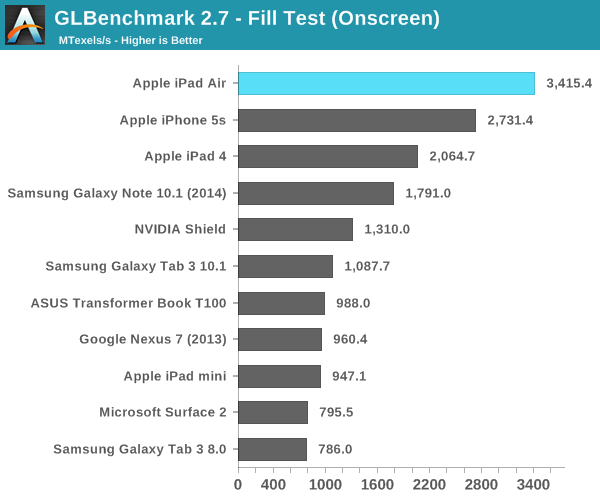
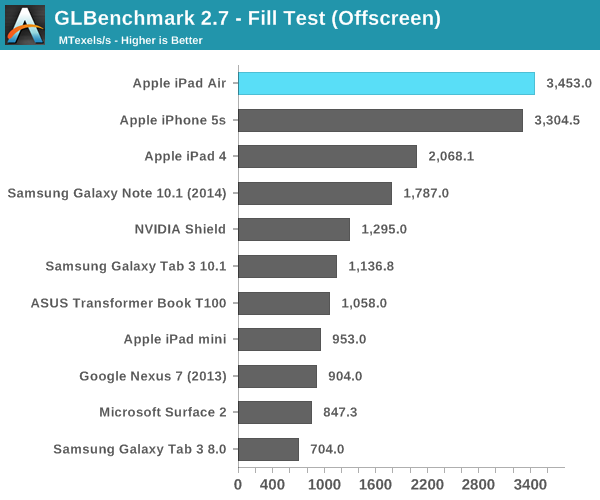
Looking at the fill rate results, there's a 4.5% increase in performance compared to the iPhone 5s. That could be the magnitude of clock increase that we're seeing between A7s. Apple could very well be relying on more thermal headroom in the iPad Air to provide any real world GPU performance advantages over the iPhone 5s.
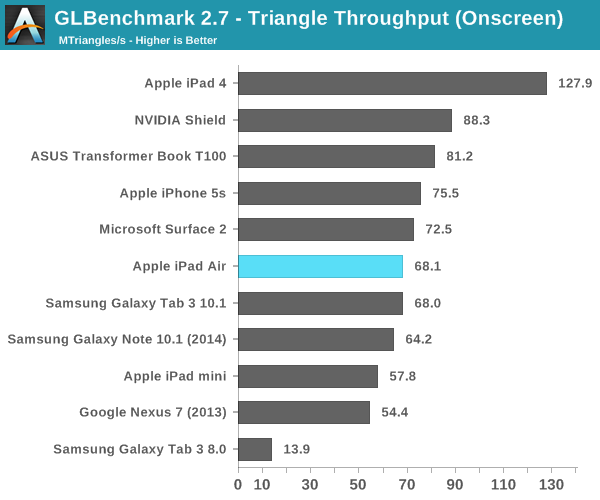

We see an even smaller gap between the Air and 5s in the triangle throughput tests (2.9%). There doesn't seem to be any substantial difference in GPU frequency between A7 implementations here. The regression in triangle rate performance compared to the iPad 4 is explained by differences in how Series 6 and Series 5XT GPUs scale in width. Whereas 5XT replicated nearly the entire GPU for "multi-core" versions, multi-cluster versions of Rogue only replicate at the shader array. The result? We don't see the same sort of peak triangle setup scaling we did back on multi-core 5XT parts. I'm not sure I'm particularly happy with the magnitude of the regression here, but I haven't seen any real world cases where it matters yet.
Next up are the game simulation tests. We'll start with the more strenuous of the two: T-Rex HD.
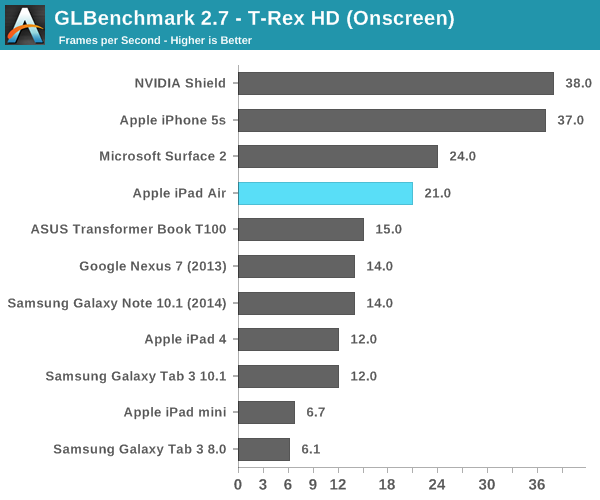
Here we get closer to Apple's claims of a 2x increase in performance. The iPad Air delivers 75% more performance than the iPad 4 in this test. Once again the iPhone 5s pulls ahead but that's because the onscreen tests render at display resolution, which is lower on the 5s.
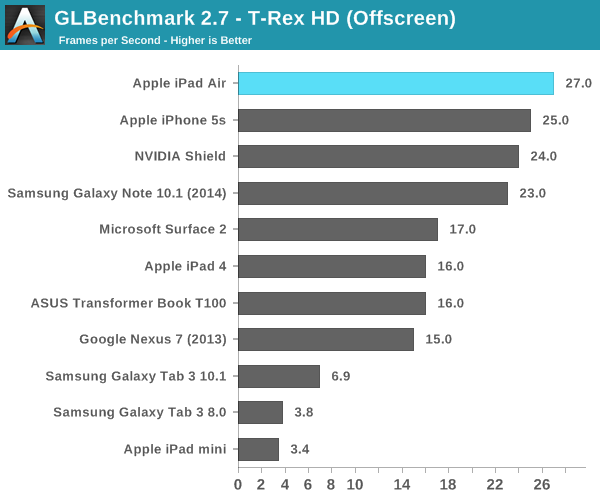
Offscreen performance sees similar scaling: ~69% better performance compared to the iPad 4.
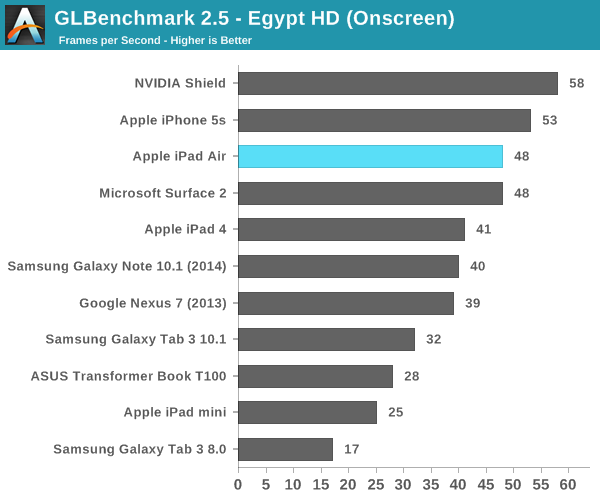
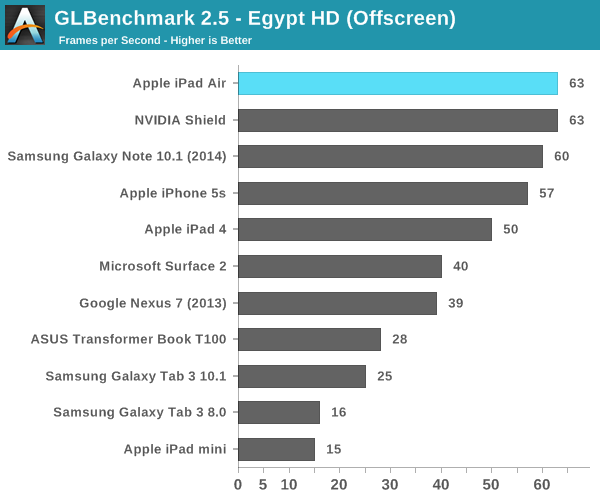
3DMark
We're once again running 3DMark's newest Unlimited mode which does its best to run independently of v-sync and at a standard resolution across all devices. I've also included 3DMark Extreme results below that feature a few more comparison points.
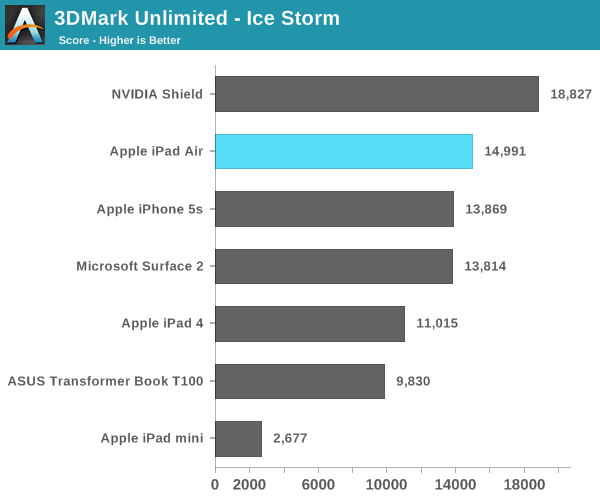
The overall Ice Storm scores show a 36% improvement in performance over the iPad 4 and an 8% increase compared to the iPhone 5s. Given the CPU frequency advantage of the A7 in the Air vs. the iPhone 5s, I'm guessing that's why we're seeing the performance gap we are here.
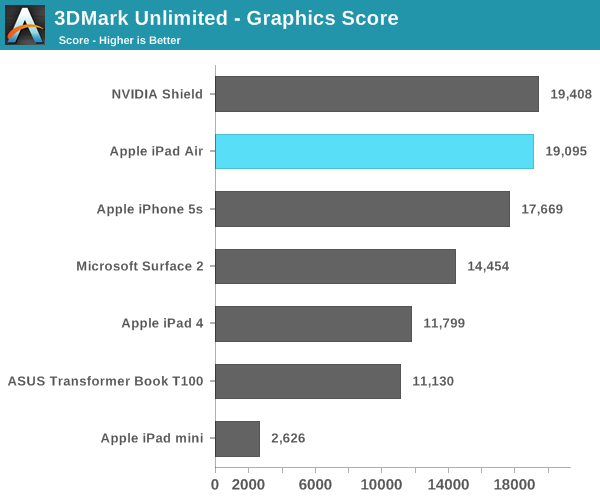
If we focus exclusively on the GPU tests (which themselves are still CPU bound), the iPad Air's performance advantage over the iPad 4 grows to over 60%.
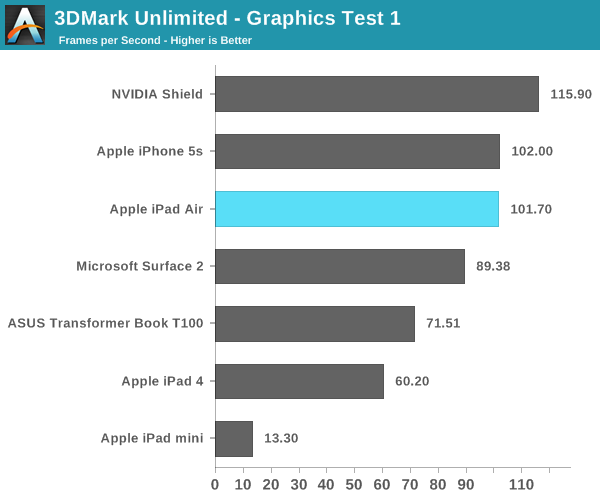
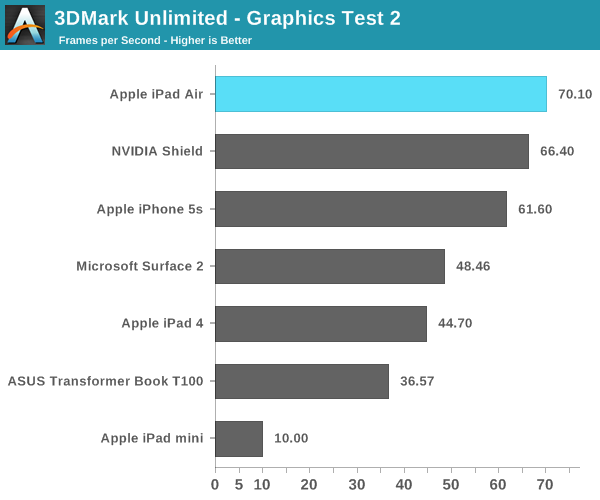
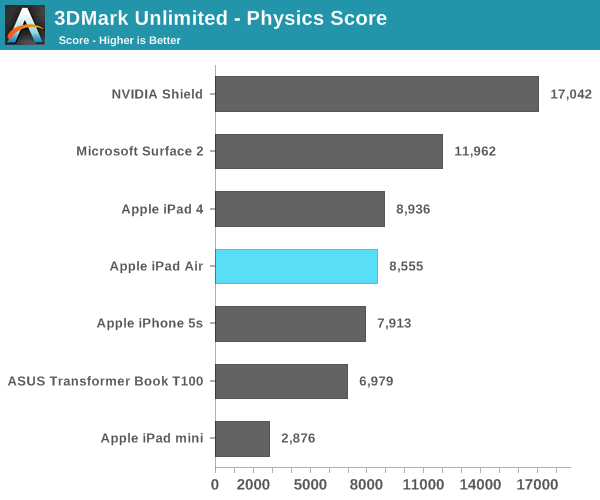
I'm still not entirely sure what's going on with the 3DMark Physics test, but we've seen this two reviews in a row now where Cyclone showed no performance increase at all compared to Swift despite this being largely a CPU test.
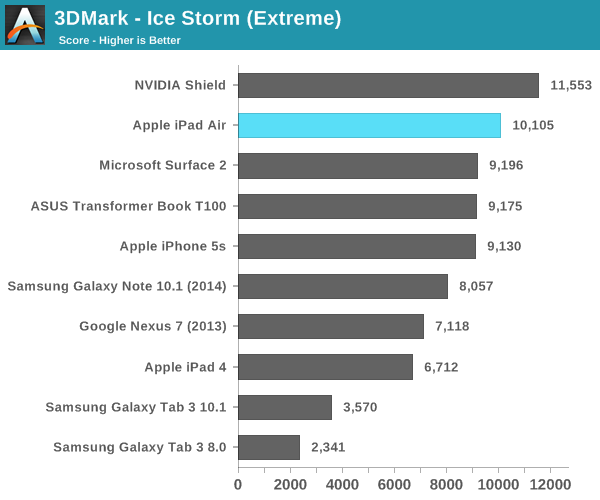
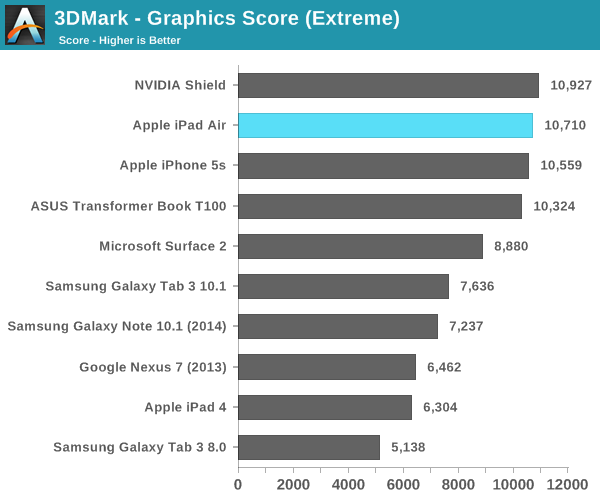
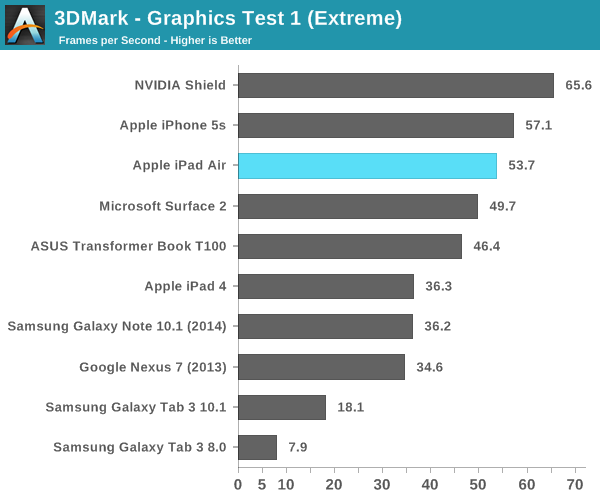
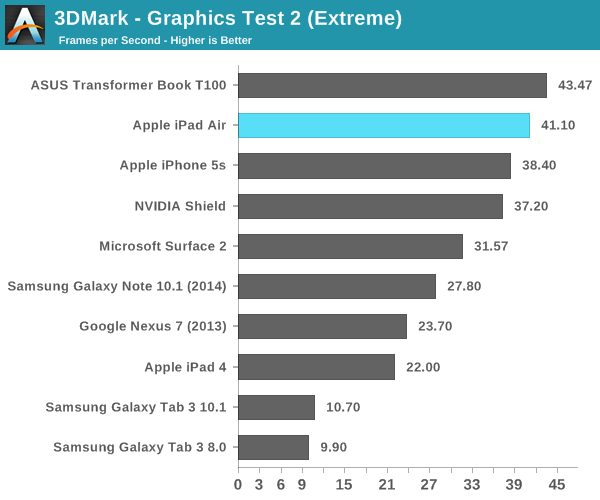

Basemark X
Basemark X is a new addition to our mobile GPU benchmark suite. There are no low level tests here, just some game simulation tests run at both onscreen (device resolution) and offscreen (1080p, no vsync) settings. The scene complexity is far closer to GLBenchmark 2.7 than the new 3DMark Ice Storm benchmark, so frame rates are pretty low.
I'm still having random issues with Basemark X reliably running both on and offscreen tests on iOS 7. Unfortunately I could only get onscreen results for the iPad Air, which came in at 46% faster than the iPad 4. Note the iPad mini and iPhone 5s benefit from having lower native resolutions here, which is why they perform so well.
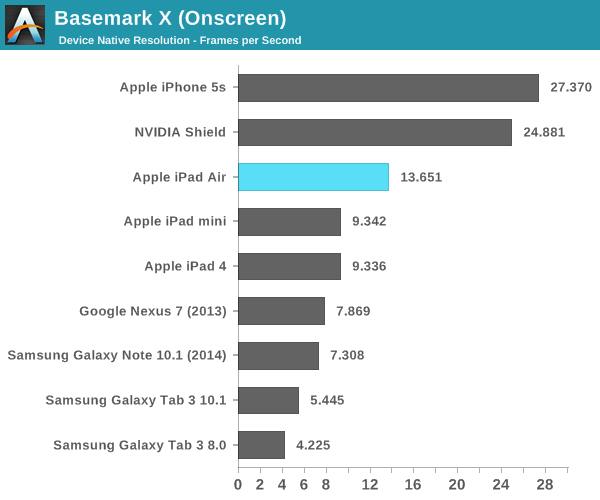










444 Comments
View All Comments
tipoo - Tuesday, October 29, 2013 - link
Agreed, a sub-name only makes sense if a second product is coming out. 12" iPad Platform based system in a MBA form factor, mayhaps?User.Name - Tuesday, October 29, 2013 - link
This device, like so many recent Apple product announcements, is both very exciting, and very disappointing at the same time.Dropping 1/3 of the weight from the iPad and making the device smaller while keeping the same display size is a huge improvement over the old hardware.
But there are so many things I have wanted Apple to address, that they have not.
1. The display is not bonded to the glass. My television from 2010 has this, so does my notebook, my phone, and Microsoft manage it with the Surface. This needs to change.
2. Even though moving to 64-bit requires more memory, they stuck with 1GB of RAM. I was already constantly running into a lack of RAM on my iPad 3.
3. It still starts at 16GB. 16GB on my iPad 2 was tight, and it got worse once apps started coming with retina assets. With no external expansion, 16GB seems awfully tight now.
4. There's no A7X. Yes, the A7 may be a fast chip, and there are less thermal restrictions inside the iPad than the iPhone, but the demands of the iPad are significantly higher. I suppose with them making the device a lot smaller, this is the compromise they thought best, but it's still disappointing.
I sold my iPad six weeks ago in preparation of the new tablet devices, fully intending on replacing it with a Surface Pro 2, but after seeing that they just stuck with the old display rather than improving its color accuracy (all they did was load an ICC profile) and the disappointing battery life, I decided against it.
Being without the iPad for six weeks though, has made me reconsider whether I want one. It was originally my fallback plan if the Surface didn't work out, but now I'm unsure that I want another. The main reason I was moving away from it to begin with was due to the software restrictions, and annoyances such as the screen reflections and lack of RAM, which have not been addressed at all with this update.
I'm having a very difficult time trying to find something which meets my requirements.
dugbug - Wednesday, October 30, 2013 - link
"4. There's no A7X. Yes, the A7 may be a fast chip, and there are less thermal restrictions inside the iPad than the iPhone, but the demands of the iPad are significantly higher. I suppose with them making the device a lot smaller, this is the compromise they thought best, but it's still disappointing."Why? Why do you need an A7X and why is that disappointing?
User.Name - Wednesday, October 30, 2013 - link
In some of the tests, it seems to be performing worse than the iPad 4.In many of the tests, performance is lower than that of the iPhone 5s - by as much as 50% in some tests.
I expect better performance from a large tablet device than I do from something which fits in my pocket.
It means that if a developer does a "simple" port from one device to the other, the iPad version is going to perform worse than the same thing running on an iPhone. I think that's very disappointing, and it's the reason the A5X and A6X existed.
errorr - Wednesday, October 30, 2013 - link
I don't think there are any apps out there that can stress the A7. I see it more that Apple chose ro put a throttled tablet SOC into a phone. It has way too much power for the 5s screen and will bottleneck elsewhere first.dugbug - Thursday, October 31, 2013 - link
The A7 has a lot of headroom, way overkill for the phone. seriously, this is such an edge concern.Kvaern - Wednesday, October 30, 2013 - link
I don't quite get the fuss about the 16gb baseline.I mean if it isn't enough for you then get a larger model but why would you want to force 32gb on people who needs no more than 16gb?
User.Name - Wednesday, October 30, 2013 - link
Apple seem to operate largely by keeping their prices fixed, and introducing better hardware at the same price point. 16GB is not a lot of storage now, considering what Apple is charging, and when there is no option to expand that.As I said in my previous post, I originally purchased a 16GB iPad 2, without knowing how restrictive that would be - you get less than 16GB usable space, and what you may not realize is that you also have to keep 1-2GB free to be able to update apps. (or at least you did at the time; iOS 7 may have changed this?)
Once apps started adding retina assets, many of them increased 2-3x in size, further reducing the number of apps you could keep on the device, even though the iPad 2 itself had no use for those assets.
I think the base spec being 16GB really hurts the user experience. I constantly found myself having to remove apps from the device, and couldn't really store any media on the device itself. (even podcasts had to be restricted)
I then went with a 64GB iPad 3 the next year, and now I would probably recommend that most people buy the 32GB model. I know too many people that bought a 16GB iPad, only to find themselves replacing the device the next year, not because they wanted a faster device, but because it didn't have enough storage for all the apps they wanted to run. (games and educational apps seem to be the worst offenders)
I'm sure there are some people whose usage is fine with 16GB, but when Apple are charging a premium price, I just don't think 16GB is enough.
It's a similar situation to the RAM in the device. 64-bit now requires more memory than previous generations of the iPad, but they stuck with 1GB of RAM, making the user experience worse than it was before.
akdj - Wednesday, October 30, 2013 - link
"64-bit now requires more memory than previous generations of the iPad, but they stuck with 1GB of RAM, making the user experience worse than it was before."Hmmm....I read the whole article, didn't notice that mentioned at ALL! Seemingly, overall...Anand's experience with the 'Air' was significantly 'better' than ANY other tablet he's reviewed/used.
As far as NAND/Storage size....this is ubiquitous throughout the industry. Most OEMs are shipping 16GB models as their 'entry' level device. For folks not interested in downloading games or 'big' apps (My mom loves her iPad 2 16GB and has never run out of space)---that amount is just fine. No other tablets are shipping with 128GB currently, right? You've got choice. Use it. Use your head. Now that you know 16GB isn't enough for you....and 64 is too much, you've finally figured out you need 32GB. Good for you....as I'd also like to see Apple start off with a 32GB iOS device as the minimum, they're not aiming the 16GB model at power users...they offer 4 different sizes with your choice of WiFi or LTE. Same thing, gotta make that choice. I'd love every model to include LTE. It doesn't. You HAVE to make a choice that benefits YOU.
Everyone uses their tablets differently. With cloud storage (Dropbox, iCloud, Box, Google Drive, et al.), one has the option to store their information outside of the tablet and access it when necessary. Many folks don't game. You can now stream from iTunes Match...no need to d/l the entire movie first. That said...if you want more storage, BUY more storage! Apple is in parity with the rest of the entry level OEMs....16GB is pretty standard, other than some that are still releasing 8GB models (first Nex7?)....or models with only options of 16 or 32GB on board.
J
User.Name - Wednesday, October 30, 2013 - link
Yes, but other devices shipping with 16GB storage are significantly cheaper, and/or have expandable storage options. (plug in a 64GB SDXC Micro card)And to move from 64GB to 128GB (+64GB) costs $100 - the same as moving from 16GB to 32GB. (+16GB)
I'm quite sure they could offer a 32GB at the current price.
As for 1GB RAM affecting the user experience, I suppose it depends how you use the device.
I was constantly running out of RAM on my iPad 3, which also had 1GB - and that is effectively more than the Air has.